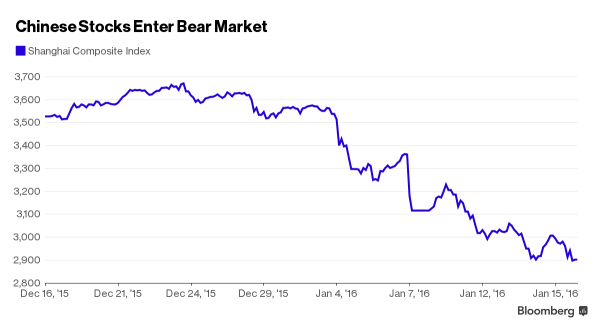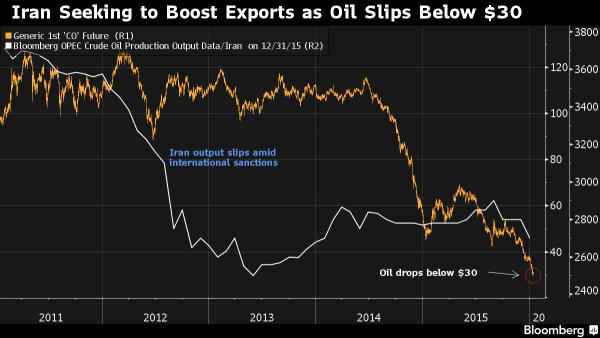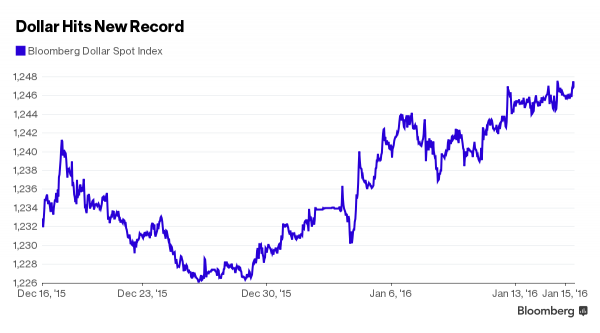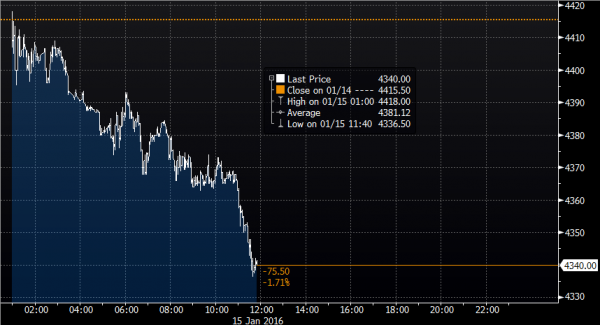“We’re gonna need a bigger Bullard”
– overheard on a trading desk this morning.
Yesterday, when looking at the market’s “Bullard 2.0” moment, which was a carbon copy of the market’s kneejerk surge higher response to Bullard’s “QE4” comments from October 17, 2014 (at least until just a few minutes prior to yesterday’s market close when suddenly selling pressure appeared), we said that either the S&P would soar – as it did in 2014 – hitting all time highs just a few months later, or the “Fed is now shooting VWAP blanks.” Judging by what has happened since, in what may come as a very unpleasant surprise to the “the market is very oversold” bulls, it appears to have been the latter.
It all started with China overnight, where shortly after the disappointing news that new bank loan creation in December rose by 597.8 billion yuan, well below the 700 billion expected (however offset by a surge in aggregate financing of 1.82 trillion yuan; far above the estimated 1.15t yuan driven entirely by new corporate bond issuance right into the world’s biggest bond bubble), the Shanghai Composite started sliding and did not stop until it dropped to just about 2,900, down 3.55% on the session, and officially entering its second bear market of the past year. The Chinese stock gauge is the world’s worst-performing global equity benchmark to start 2016, and the Composite has now fallen to levels last seen in 2014, wiping out all gains from China’s unprecedented state-rescue campaign.

In addition to the new loan disappointment, adding negative pressure to stocks was a report that some banks in Shanghai have stopped accepting shares of smaller listed companies as collateral for loans.
Then there was oil, which after flirting with $30 for the past two days, finally broke the psychological support barrier with gusto, and both WTI and Brent have tumbled by about 5% and 4% respectively at last check, and substantially below $30, driven first by rising fears of the imminent landfall of millions of barrels of Iran oil the moment the sanctions are officially lifted as soon as Monday…

… and then about 3 hours ago a new report by Goldman reiterated supply fears, when it once again hinted at $20 oil, although adding that was not its baseline forecast yet, and that it was keeping its $40 oil price target:
While the surplus in oil continues to pressure oil timespreads wider and reversed the WTI-Brent spread as European surpluses are moved to the US Gulf Coast where spare storage exists, we still aren’t adopting the $20/bbl scenario as our baseline forecast since balances have not deteriorated further following our mid-December update. Barring a supply or demand/weather shock that shifts the balance by more than 340,000 b/d we don’t see the oil market hitting storage capacity constraints, which is why we are maintain our $40/bbl WTI price forecast for 1H16.
The market read between the lines and is already trading as if $20 oil is here. As a result,
Norway sees a crisis in its industry, energy firms are laying off workers and currency markets from commodity-producing countries are in turmoil. The slump is also denting the outlook for inflation around the world, causing traders to curb bets on how far the Federal Reserve will raise interest rates this year.
Also not helping oil was another bout of strength in the US dollar, even as doubts grow about the Federal Reserve’s ability to raise interest rates four times in 2016. According to Bloomberg, the gauge tracking the performance of the dollar against 10 of its leading global peers is heading for a third weekly gain, the longest stretch since July. As a result the Bloomberg Dollar Spot index just hit a new record high…

… and while the dollar surges, the all important Yen carry trade is getting unwound pushing the USD/JPY down 100 pips overnight, and slamming US equity futures which were down over 30 points at last check, or down 1.6% to 1884. Elsewhere, stocks fell around the world and bonds gained as the outlook for inflation soured while a measure of credit risk for investment-grade companies in Europe climbed for an eighth day.
Among other commodities, the latest plunge in copper is notable, which as of this morning has dropped nearly 2% to a fresh 6 year low…

… which in turn has sent the stock of our old friend Glencore relling, down 8.5%. It’s not better elsewhere: as Bloomberg notes, industrial metals headed for the first back-to-back weekly decline since November on signs of further slowing demand in the Chinese economy and after oil prices dropped. Mining shares also sank. All base metals fell on Friday and the LME Index of six metals has lost 1 percent this week.
The Stoxx Europe 600 Index retreated 1.4%, heading for a weekly drop of 1.5 percent. Europe’s benchmark has tumbled 19 percent since an April high, inching closer to the common definition of a bear market. Shares are trading at 14.2 times estimated earnings, the lowest in about a year. The Euro Stoxx 50 Index entered a bear market this week.












Leave A Comment